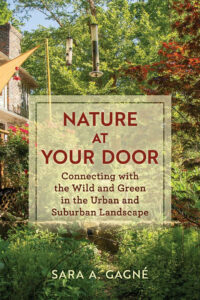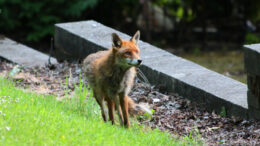Last summer I took advantage of my break from teaching by enjoying long, daily walks around my neighborhood. I indulged my mind and body in the blueness, stillness, and leafiness that is North Carolina in June and July. It’s truly astounding how many leaves a willow oak can cram into one tiny piece of sky.
On my walks, the yard of one house stuck out. It was unlike any yard I’ve seen around my city or in any of the other cities in the United States, Canada, and Australia where I’ve lived. It is a forest yard. Nearly a dozen large trees are interspersed amid a dense stand of saplings and shrubs. That summer, leaf litter covered the ground. The top of the house was only visible if I craned my neck to see down the paved driveway, itself narrowing and crumbling as roots, lichens, and fungi worked their inexorable magic.
Depending on your perspective, the house with the forest yard could be seen either as an eyesore — and the scariest place to trick-or-treat — or, as in my case, the most splendid place imaginable.

At this point, I should probably mention that I’m an urban ecologist and that the forest yard makes my heart flutter at the possibility and hope of nature in cities.
I looked at aerial images for the area, and they revealed that the trees around that home, which haven’t been actively “managed,” are about 50 years old. Over that time the forest yard has accumulated a bewildering array of species and ecological interactions. Its tulip poplars, walnuts, cedars, redbuds, pines, and willow oaks have soaked up the atmosphere’s carbon dioxide and turned it into much-needed habitat for wildlife: butterflies, bees, and other insects; lizards, snakes, and turtles; frogs and toads; birds; and mammals. It’s home to a multitude of soil invertebrates and fungi that keep the business side of an ecosystem — aka decomposition — going. All the species that share this shady third-of-an-acre lot are intertwined in a complex tangle of relationships that keeps them fed and feeding on one another, interdependent to varying degrees for their life and livelihood.
And all of this exists amidst a matrix of roads, single-family and multiplex housing, commercial plazas, light industry, and high rises that make up a medium-sized city in the Southeast. The forest yard is a little island of nature in a nearly lifeless sea of concrete, asphalt and lawn.
But, to my inexhaustible surprise, that sea of concrete, asphalt, and lawn is not as empty as we tend to assume. Very far from it. Places of dense human habitation are also where many species reside, including some that are threatened. A recent analysis of the birds and plants that occur in 147 cities across the globe revealed that the sampled cities were home to 2,041 bird species — about one-fifth of Earth’s total avian diversity — and 14,240 plant species. These include 36 bird and 65 plant species threatened with global extinction.
To get a better idea of just how much of the urban biodiversity iceberg lies below the surface of our awareness, consider this: Last year participants in the City Nature Challenge made nearly 1.9 million observations in 480 cities, with the residents of the La Paz metropolitan area in Bolivia recording the high score of 5,320 species.
View this post on Instagram
Add to this the estimate that we share our homes and yards with an average of 9,000 species of fungi and bacteria and you’ll begin to suspect, as I do, that cities are in fact incredibly biodiverse. And it’s not just the all-too-rare forest yard: Scientific evidence shows that the more people you find in a place, the more types of birds, mammals, and plants you’ll find there too.
So why don’t we see it that way? Why do we perceive our urban centers as unworthy and undeserving of our conservation efforts and attention?
One of the reasons we assume that cities are biological deserts, wholly manufactured for our needs and ignoring those of others, is that we don’t seek out — and therefore are not aware of — the other species that live amongst us. We spend 21 of every 24 hours indoors. When we do go outside, we disqualify the pockets of green and blue and brown in our urban and suburban surroundings as examples of real nature. They’re just yards and heavily managed parks; how natural could they be?
But, more and more, I and others who love nature where they live are finding a sparkling array of species right under our noses. I usually don’t have to search under too many rocks in the most urban of streams – the kind with the ominous algae, silt-covered rocks, and overall sludgy appearance that makes me wash my hands as soon as I get home — before I find a slim and sleek two-lined salamander.
And now that I’ve identified the native yellow passionflower vine that pushes up from the ground in my garden each spring, I see it everywhere: intertwined with otherwise immaculate hedges, along roadsides, and in the shady edges of parks. That’s good news for the passionflower bee who relies exclusively on the small, delicate, satellite-dish flowers for pollen.
And last spring, when I checked my neighborhood’s new stormwater pond for amphibian activity, I was surprised to find green and gray treefrogs trilling their little tails off in a water-filled grassy depression in the active construction site next door.
Last but not least, I’ve got to give a shout-out to Mecklenburg County Nature Preserves and Natural Resources staff, who have identified 899 species of moth (and counting) where I live. That’s nearly one moth species per 1,200 county residents in one of the top 25 metropolitan areas in the country.
Our typical lack of awareness of urban wildlife is why the forest yard is so striking. It’s shocking to see nature so readily thrive in a space nominally dedicated to people, almost as if it were trespassing. The forest yard confronts us with what we perceive as uncontrolled growth, unseen animals, fungi, and bacteria creeping and crawling as they feed, reproduce, and die all on their own without intervention from us. The forest yard represents the unknown exactly where it should not be, in the dictated and ordered landscapes that are our cities.
But, as with all unknowns, the forest yard’s power to disconcert and disturb dissolves the more we get to know it — and smaller spaces like it.
Put that to the test. Many of you reading this already have the iNaturalist app downloaded onto your phones to use whenever you’re hiking or in the field — you know, in real nature. But sometime soon, give it a try closer to home. Take a wander around your yard, your street, or your local park or greenway – somewhere familiar. As you go, use the app to take pictures of the fungi, plants and animals you come across and let iNaturalist tell you what species they are. No matter how urban your neighborhood is, I guarantee you that your perception of it will change — from a wasteland to a world filled with tawny emperors, modest masked bees, indigo buntings, magpie inkcaps, marbled salamanders, hedgehog slugs, labyrinth orbweavers, bearded beggarticks, and much, much more.
As you meet these new neighbors, you’ll start noticing even more: sun beetles crossing the sidewalk in front of you, cedar waxwings in the treetops, and native wildflowers in the median at a stoplight. Eventually you’ll realize you don’t need to go to the nearest state park or wildlife preserve to experience nature; you’ll begin to seek out your newfound neighbors by taking more walks, exploring your park with your kids, or I as recently did, watching chimney swifts congregate at dusk. And once those things start to happen more and more, you’ll see more and more opportunities to enhance and protect the wild plants and animals that share your suburban or urban home.
That’s just the neighborly thing to do.
![]()
Get more from The Revelator. Subscribe to our newsletter, or follow us on Facebook and X.
Previously in The Revelator:
Urban ‘Microrewilding’ Projects Provide a Lifeline for Nature


